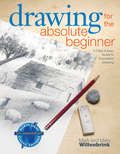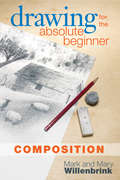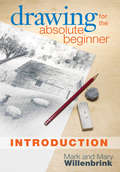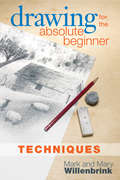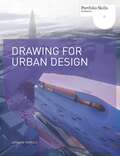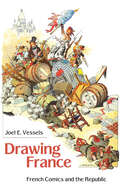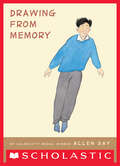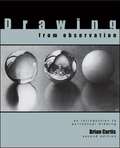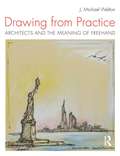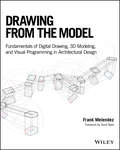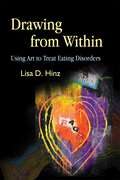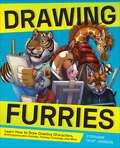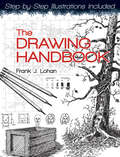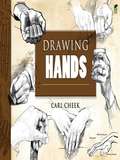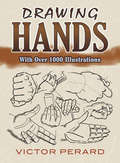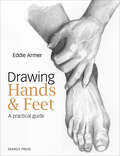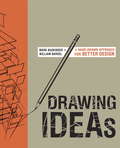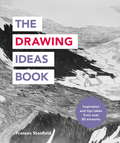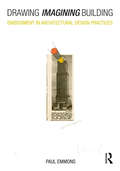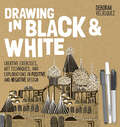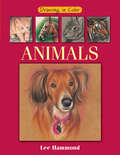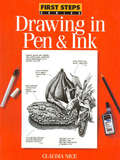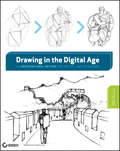- Table View
- List View
Drawing for the Absolute Beginner: A Clear & Easy Guide to Successful Drawing (Art for the Absolute Beginner)
by Mary Willenbrink Mark WillenbrinkThis inspiring book makes drawing in a realistic style easier than you may think and more fun than you ever imagined! Authors Mark and Mary Willenbrink (Watercolor for the Absolute Beginner) cover it all-from choosing materials and the correct way to hold your pencil, to expert advice on the tricky stuff, like getting proportions and perspective right, drawing reflections, and designing strong compositions. (It's not as scary as it sounds...not with Mark and Mary as your guide!) At the heart of this book, a series of fun, hands-on exercises help you practice and perfect your strokes-24 mini-demos lead up to 9 full step-by-step demos. Each exercise builds on the previous one as you develop your skills, build your confidence, and enjoy yourself along the way. The lessons you learn by drawing simple subjects such as coffee mugs, clouds and trees will help you take on progressively more challenging matter like animals, still lifes, landscapes and portraits...the kinds of subjects and scenes you've always dreamt of drawing. This book is just the ticket for budding artists of any age. It's never too early and never too late to discover the pure joy of drawing!
Drawing for the Absolute Beginner, Composition
by Mark WillenbrinkThis e-book contains nine detailed step-by-step demonstrations on composition, texture, perspective and storytelling and includes a glossary of common art terms. It is based on Drawing for the Absolute Beginner (North Light 2006) by Mark and Mary Willenbrink.
Drawing for the Absolute Beginner, Introduction
by Mark WillenbrinkYou won't be disappointed with the basic instruction based on the popular print book Drawing for the Absolute Beginner (North Light 2006) by Mark and Mary Willenbrink. Learn all you need to know about getting started sketching and drawing including materials, basic techniques and perspective. Also includes a glossary of common art terms. The Absolute Beginner series of e-books will inspire anyone who wants to make art to create realistic artwork for any subject, including still life, landscapes, animals and people.
Drawing for the Absolute Beginner, Techniques
by Mark WillenbrinkYou won't be disappointed with the basic instruction based on the popular print book Drawing for the Absolute Beginner (North Light 2006) by Mark and Mary Willenbrink. Learn all about value and shadows, and get more than 15 step-by-step technique exercises on how to draw still lifes, animals and people. Also includes a glossary of common art terms. The Absolute Beginner series of e-books will inspire anyone who wants to make art to create realistic artwork for any subject, including still life, landscapes, animals and people.
Drawing for Urban Design
by Lorraine FarrellyArchitects and urban planners need to describe cities in the course of their work, be it through maps, diagrams, sketches, computer renderings or models. Drawing for Urban Design explores a wide range of ways to represent the city, from freehand sketching to sophisticated computer models. The book provides a practical introduction to these techniques for students while explaining the processes associated with describing and designing urban environments – it is an invaluable visual handbook for representing the contemporary city.
Drawing for Urban Design (Portfolio Skills)
by Lorraine FarrellyArchitects and urban planners need to describe cities in the course of their work, be it through maps, diagrams, sketches, computer renderings or models. Drawing for Urban Design explores a wide range of ways to represent the city, from freehand sketching to sophisticated computer models. The book provides a practical introduction to these techniques for students while explaining the processes associated with describing and designing urban environments – it is an invaluable visual handbook for representing the contemporary city.
Drawing France: French Comics and the Republic
by Joel E. VesselsIn France, Belgium, and other Francophone countries, comic strips—called bande dessinee or “BD” in French—have long been considered a major art form capable of addressing a host of contemporary issues. Among French-speaking intelligentsia, graphic narratives were deemed worthy of canonization and critical study decades before the academy and the press in the United States embraced comics. The place that BD holds today, however, belies the contentious political route the art form has traveled. In Drawing France: French Comics and the Republic, author Joel E. Vessels examines the trek of BD from it being considered a fomenter of rebellion, to a medium suitable only for semi-literates, to an impediment to education, and most recently to an art capable of addressing social concerns in mainstream culture. In the mid-1800s, alarmists feared political caricatures might incite the ire of an illiterate working class. To counter this notion, proponents yoked the art to a particular articulation of “Frenchness” based on literacy and reason. With the post-World War II economic upswing, French consumers saw BD as a way to navigate the changes brought by modernization. After bande dessinee came to be understood as a compass for the masses, the government, especially Francois Mitterand’s administration, brought comics increasingly into “official” culture. Vessels argues that BD are central to the formation of France’s self-image and a self-awareness of what it means to be French.
Drawing From Memory
by Allen SayCaldecott Medalist Allen Say presents a stunning graphic novel chronicling his journey as an artist during WWII, when he apprenticed under Noro Shinpei, Japan's premier cartoonistDRAWING FROM MEMORY is Allen Say's own story of his path to becoming the renowned artist he is today. Shunned by his father, who didn't understand his son's artistic leanings, Allen was embraced by Noro Shinpei, Japan's leading cartoonist and the man he came to love as his "spiritual father." As WWII raged, Allen was further inspired to consider questions of his own heritage and the motivations of those around him. He worked hard in rigorous drawing classes, studied, trained--and ultimately came to understand who he really is. Part memoir, part graphic novel, part narrative history, DRAWING FROM MEMORY presents a complex look at the real-life relationship between a mentor and his student. With watercolor paintings, original cartoons, vintage photographs, and maps, Allen Say has created a book that will inspire the artist in all of us.
Drawing from Observation: An Introduction to Perceptual Drawing
by Brian CurtisPerceptual drawing, in which one renders the physical world as it appears to an observer, is the focus of this new text for the introductory drawing course. With an emphasis on progressive skill development, Drawing from Observation offers a balanced mix of hands-on technique and perceptual theory while making a compelling argument for the long-term value of studying perception-based drawing.
Drawing from Practice: Architects and the Meaning of Freehand
by J. Michael WeltonDrawing from Practice explores and illuminates the ways that 26 diverse and reputable architects use freehand drawing to shape our built environment. Author J. Michael Welton traces the tactile sketch, from initial parti to finished product, through words, images, and photographs that reveal the creative process in action. The book features drawings and architecture from every generation practicing today, including Aidlin Darling Design, Alberto Alfonso, Deborah Berke, Marlon Blackwell, Peter Bohlin, Warren Byrd, Ellen Cassilly, Jim Cutler, Chad Everhart, Formwork, Phil Freelon, Michael Graves, Frank Harmon, Eric Howeler and Meejin Yoon, Leon Krier, Tom Kundig, Daniel Libeskind, Brian McKay Lyons, Richard Meier, Bill Pedersen, Suchi Reddy, Witold Rybczynski, in situ studio, Laurinda Spear, Stanley Tigerman, and Tod Williams Billie Tsien Architects. Included is a foreword by Robert McCarter, architect, author and professor of architecture.
Drawing from the Model: Fundamentals of Digital Drawing, 3D Modeling, and Visual Programming in Architectural Design
by Frank MelendezBridges traditional and contemporary methods of creating architectural design drawings and 3D models through digital tools and computational processes. Drawing from the Model: Fundamentals of Digital Drawing, 3D Modeling, and Visual Programming in Architectural Design presents architectural design students, educators, and professionals with a broad overview of traditional and contemporary architectural representation methods. The book offers insights into developments in computing in relation to architectural drawing and modeling, by addressing historical analog methods of architectural drawing based on descriptive geometry and projection, and transitioning to contemporary digital methods based on computational processes and emerging technologies. Drawing from the Model offers digital tools, techniques, and workflows for producing architectural design drawings (plans, sections, elevations, axonometrics, and perspectives), using contemporary 2D drawing and 3D modeling design software. Visual programming is introduced to address topics of parametric modeling, algorithmic design, computational simulations, physical computing, and robotics. The book focuses on digital design software used in higher education and industry, including Robert McNeel & Associates Rhinoceros® (Rhino 6 for Windows), Grasshopper®, Adobe Illustrator® CC, and Arduino, and features an appendix filled with 10 design drawing and 3D modeling exercises intended as educational and pedagogical examples for readers to practice and/or teach workflows that are addresses in the book. Bridges analog hand-drawing and digital design drawing techniques Provides comprehensive coverage of architectural representation, computing, computer-aided drafting, and 3D modeling tools, techniques, and workflows, for contemporary architectural design drawing aesthetics and graphics. Introduces topics of parametric modeling, algorithmic design, computational simulation, physical computing, and robotics through visual programming environments and processes. Features tutorial-based instruction using the latest versions of Rhinoceros® (Rhino 6 for Windows), Grasshopper®, Adobe Illustrator® CC, and Arduino.
Drawing from Within: Using Art to Treat Eating Disorders
by Lisa HinzDrawing from Within is an introductory guide for those wanting to explore the use of art with clients with eating disorders. Art therapy is a particularly effective therapeutic intervention for this group, as it allows them to express uncomfortable thoughts and feelings through artistic media rather than having to explain them verbally. Lisa D. Hinz outlines the areas around which the therapist can design effective treatment programmes, covering family influences, body image, self-acceptance, problem solving and spirituality. Each area is discussed in a separate chapter and is accompanied by suggestions for exercises, with advice on materials to use and how to implement them. Case examples show how a therapy programme can be tailored to the individual client and photographs of client artwork illustrate the text throughout. Practical and accessible to practitioners at all levels of experience, this book gives new hope to therapists and other mental health professionals who want to explore the potential of using art with clients with eating disorders.
Drawing Furries: Learn How to Draw Creative Characters, Anthropomorphic Animals, Fantasy Fursonas, and More (How to Draw Books)
by Ifus MoraineBring your furry characters to life with this step-by-step guide to drawing anthropomorphic dogs, foxes, wolves, unicorns, dragons, and more of your favorite creatures!Grab your sketchbook and start drawing today with this step-by-step instructional handbook for creating your own furry characters. Combining human and animal features can be daunting, but with the right tips and tricks you&’ll be illustrating your favorite furries and fursonas in no time. With Drawing Furries you&’ll learn the basics of proportions, facial expressions, and body shapes before moving on to creating fun characters based on all types of animals and creatures, including dogs, rabbits, dinosaurs, otters, gryphons, and more! And of course, the book also includes tons of examples, ideas, and tips for personalizing your creations as well as creating your own character palette. Created by a professional artist who specializes in furry art, this is the perfect art tool for those already a part of the furry fandom or those just starting off!
The Drawing Handbook (Dover Art Instruction)
by Frank J. LohanDesigned for beginning and amateur artists, this guide to the essentials of drawing features comprehensive, easy-to-follow lessons and more than 500 detailed illustrations. Frank Lohan, a renowned artist and popular instructor, conducts readers through each step of the creative process, from grasping the concepts of perspective and proportion to producing lifelike drawings of a variety of subjects--landscapes, architecture, animals, flowers, and faces. Step-by-step exercises focus on attaining the fundamentals of composition, visualizing the geometry of the subject, working with perspective, and mastering drawing techniques for both pencil and pen and ink. Each exercise includes gridded outline compositions to help students develop their drawing abilities. Suggestions for the selection and use of tools will assist in achieving professional-quality results.
Drawing Hands
by Carl CheekAn indispensable and easy-to-follow companion for the intermediate art student, this concise guide focuses on how to capture the natural representation of the human hand in all its forms and motions.Over 100 clear and expertly rendered drawings help artists discover:* The subtle but crucial differences between hands of young and old, male and female* How to accurately draw hands engaged in a variety of activities* Skeletal and muscular depictions, which help reveal how to naturally draw the workings of the magnificent human handEducated in England at the Chelsea School of Art and the Royal College of Art, the works of Carl Cheek were widely exhibited in Europe throughout the 1950s. His artwork is included in numerous private and public collections, including Britain's important and often-visited Government Art Collection.
Drawing Hands: With Over 1000 Illustrations (Dover Art Instruction)
by Victor PerardSecond in importance only to the face, hands play a key role in expressing emotional states—from anger and fear to resignation, serenity, and surprise. This resource features more than 1,000 illustrations, offering figure artists at all skill levels insights into the structure, character, and expression of hands. Artist and instructor Victor Perard emphasizes the anatomy of the hand: the bones that make up its framework and define its proportions and the muscles that direct its actions. In addition to notes on proportion and perspective, he groups the illustrations of hands in a manner that accents the modifications of their form as they are viewed from various angles. The tremendous variety of images ranges from male and female hands engaged in work and leisure activities to the hands of athletes, babies, and the elderly.
Drawing Hands & Feet
by Eddie ArmerAn essential guide to what is regarded as a challenging subject, this book will simplify and inspire artists to approach drawing hands and feet with precision and confidence. Eddie Armer presents a comprehensive course that will guide the artist through everything from which drawing materials to use, through to mastering proportion, perspective, light and shade. The result will be the accurate portrayal of hands and feet at rest, in motion and performing intricate tasks in a variety of different poses. With his experience, knowledge and love of the subject, Eddie will teach you how to understand the underlying anatomy of the subjects and the whole drawing process with helpful tips and advice, exercises and projects. This is an exhaustive, must-have book, a true masterclass from a true master of the medium, that will inspire any artist who wants to create realistic and characterful drawings of hands and feet.
Drawing Ideas
by Mark Baskinger William BardelA primer for design professionals across all disciplines that helps them create compelling and original concept designs by hand--as opposed to on the computer--in order to foster collaboration and win clients. In today's design world, technology for expressing ideas is pervasive; CAD models and renderings created with computer software provide an easy option for creating highly rendered pieces. However, the accessibility of this technology means that fewer designers know how to draw by hand, express their ideas spontaneously, and brainstorm effectively.In a unique board binding that mimics a sketchbook, Drawing Ideas provides a complete foundation in the techniques and methods for effectively communicating to an audience through clear and persuasive drawings.
The Drawing Ideas Book
by Frances StanfieldRefresh your creativity and boost your motivation to draw with the expert help of The Drawing Ideas Book.If you're stuck in a rut - or simply just stuck - this book is filled with ideas for what to draw, how to draw and even where and when to draw. Packed with arresting examples of creatives' drawings and sketchbooks from all over the world, it's sure to fire up your creativity.Imagine it, doodle it, sketch it, ink it and more. Discover the infinite possibilities of this essential art form, from its key mediums to unusual processes, across subjects from figure drawing and landscape sketching to abstract compositions.
The Drawing Ideas Book
by Frances StanfieldIf you're stuck in a rut - or simply just stuck - this book is filled with ideas for what to draw, how to draw and even where and when to draw. Packed with arresting examples of creatives' drawings and sketchbooks from all over the world, it's sure to fire up your creativity.Imagine it, doodle it, sketch it, ink it and more. Discover the infinite possibilities of this essential art form, from its key mediums to unusual processes, across subjects from figure drawing and landscape sketching to abstract compositions.
Drawing Imagining Building: Embodiment in Architectural Design Practices
by Paul EmmonsDrawing Imagining Building focuses on the history of hand-drawing practices to capture some of the most crucial and overlooked parts of the process. Using 80 black and white images to illustrate the examples, it examines architectural drawing practices to elucidate the ways drawing advances the architect’s imagination. Emmons considers drawing practices in the Renaissance and up to the first half of the twentieth century. Combining systematic analysis across time with historical explication presents the development of hand-drawing, while also grounding early modern practices in their historical milieu. Each of the illustrated chapters considers formative aspects of architectural drawing practice, such as upright elevations, flowing lines and occult lines, and drawing scales to identify their roots in an embodied approach to show how hand-drawing contributes to the architect’s productive imagination. By documenting some of the ways of thinking through practices of architectural handdrawing, it describes how practices can enrich the ethical imagination of the architect. This book would be beneficial for academics, practitioners, and students of architecture, particularly those who are interested in the history and significance of hand-drawing and technical drawing.
Drawing in Black & White: Creative Exercises, Art Techniques, and Explorations in Positive and Negative Design
by Deborah Velasquez&“The style of this book is loose and easy, about having fun, and learning to work within the confines of black and white rather than depending on color.&” —Art Elements Working with only positive and negative lines and shapes keeps the focus on the basics: composition, balance, and harmony. And using white and black gel, ink, and paint pens on black, tan, and gray papers allows you to experience drawing in a whole new way! Drawing in Black & White is a clever drawing and design book that contains 36 inspiring exercises and a gallery of artwork. Follow the tips and draw on black, gray, and tan paper to learn how different colored papers can make simple images pop. You&’ll find lessons on drawing, pattern drawing, drawing with cut paper, and simple collage. Learn to see your drawings a new way by drawing in black and white! &“While confined to only two colors, black and white, this guide&’s techniques, materials, and tools are not nearly so limited . . . Readers with some experience drawing and painting are the best audience for this guide, but there is plenty here for beginners and advanced artists, too.&” —Library Journal &“The goal of the book is to let you be familiar with black and white media, to draw and have fun . . . It&’s a fun activity book for those who want to dabble with art.&” —Parka Blogs
Drawing in Color ANIMALS: Animals (Drawing in Color)
by Lee HammondHammond's easy-to-follow techniques enable even first-time artists to render a variety of wonderful animals, from cats and dogs to horses, squirrels, tigers and more.
Drawing in Pen & Ink (First Steps)
by Claudia NiceGot a yearning to pick up a pen and see what you can do? Go for it! But don't sketch alone—let popular artist and teacher Claudia Nice be your guide. She'll make your first steps fun and successful! In her trademark style—friendly and encouraging—Claudia will show you how to do a sketch of a subject that actually ends up looking like the subject. And she shares her secrets for turning simple lines and dots into all kinds of lifelike textures, including leaves, glass, hair, fruit, water, clouds, wood grain, grass, fur and feathers. Easy (and fun!) exercises get you started. Step-by-step projects teach techniques as you draw trees, flowers, barns, animals and other subjects—even people! And demonstrations show you how to put all that you've learned together to create a finished picture. So go ahead—grab that pen and have fun! Just follow along with Claudia to get the hang of it, and before you know it you'll be making your own, original pen-and-ink drawings!
Drawing in the Digital Age
by Wei XuA solid foundation for improving your drawing skillsTeaching a new observational method based on math and computer graphics principles, this book offers an innovative approach that shows you how to use both sides of your brain to make drawing easier and more accurate. Author Wei Xu, PhD, walks you through his method, which consists of scientific theories and principles to deliver real-world techniques that will improve your drawing skills. Xu's pioneering approach offers a solid foundation for both traditional and CG artists. Encourages you to use both sides of your brain for drawing with the highest efficiency possibleIntroduces an innovative method invented by the author for improving your drawing skillsIf you are eager to learn how to draw, then this book is a must read.
